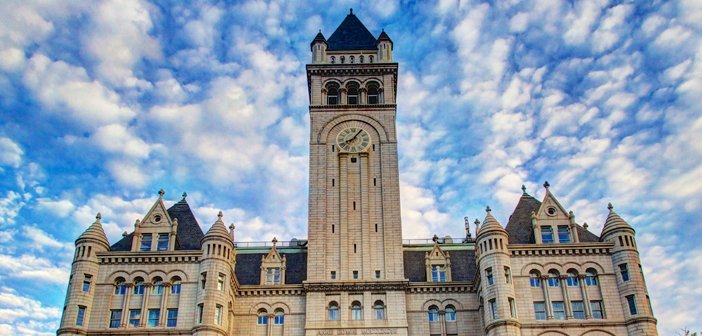Benefits, considerations and practical advice on how to breathe new life into an old structure.
By Stephen Siegel
Adaptive reuse is generally defined as the process of reusing an old site or building for a purpose other than that for which it was built or designed. Reconstructing an existing building whose most recent use was non-hospitality into a hotel can be an attractive development model for the hospitality sector, for both municipalities and developers.
Today, many cities have prominent structures with a solid physical plant in excellent locations. These buildings can be an excellent fit for redevelopment through public-private partnerships. These projects help municipalities meet their urban planning objectives, spark economic activity and grow the tax base. The alternative often leads to a vacant building in disrepair and blight to the neighborhood.
The municipality further benefits from the economic impact brought about by these projects. The construction itself creates jobs and ancillary expenditures to the local community. The new hotel creates many operating jobs and the guests visiting the hotel further stimulate local businesses such as restaurants and entertainment venues.
Reaping the benefits
For developers, these projects provide substantial benefits. First, the opportunity to obtain locations within high-barrier-to-entry markets. Second, the potential to reduce the entitlement process and construction time since both the infrastructure and utilities already exist. Third, many municipalities offer economic benefits such as tax credits, bond financing and other incentives that can substantially lower total development costs.
Certainly, adaptive reuse can yield some of the hotel sector’s most glamorous and noteworthy achievements. For instance, an historic Beaux-Arts bank can become a boutique luxury hotel in a resurgent downtown setting. A former warehouse or manufacturing facility can be transformed into a waterfront mixed-use development that features a hotel as one of the anchors. Other structures such as office buildings, apartments, hospitals or former government buildings such as a school, fire or police headquarters are also outstanding candidates for adaptive reuse. Adaptive-reuse developers are only limited in their imagination and the willingness of municipalities to participate and help defray costs.
How to identify a proper candidate
Identifying a viable hospitality candidate for adaptive reuse requires considerable effort. And having a suitable candidate is only the first step. The right market opportunity, within a municipality that is receptive to the adaptive reuse and one that will support the economic incentives that may be necessary for it to be feasible, is paramount. Another factor often underestimated is the endorsement from the local community, whose support can easily make or break a project’s success.
Adaptive reuses can complicate already complex planning, zoning and permitting procedures. Sometimes current building codes cannot be met due to existing conditions, and variances to current planning and building codes may be required. The local jurisdiction needs to understand these challenges and be willing to grant these exceptions, to a certain extent. It is helpful to be in communication with the local economic development contact, especially if infrastructure improvements are needed for the project. These improvements may rely on obtaining tax credits or other incentives to make the project feasible.
Lastly, if the project warrants a franchise, it is essential to identify the appropriate brand and obtain franchise approval. Some building shells and dimensions may not fit the prototypical room criteria of certain brands. For example, a building may work for extended stay, but not full-service, or vice versa. The market may not be conducive for a particular brand or the desired brand may not be available. We have found that franchisors will do their best to accommodate less-than-ideal footprints if the location is desired by the brand and the developer/sponsor is a partner with whom the franchisor has confidence in their ability to develop and operate the property in accordance with brand standards.
Forging ahead
Once a building has been identified, and both the municipality and prospective brand (if desired) have interest, it is time to dig deeper into a host of due diligence and entitlement challenges before the jackhammers and saws are powered on. This process includes determining the fitness of the physical plant, i.e. structural integrity, mechanical/electrical systems functionality and confirming the available utilities such as water service, sewer, power and gas.
An article in itself can be written on each of the above challenges, but let’s touch on a few of these issues.
The best candidates must begin with a building that is structurally stable and sound. It is good practice to engage a structural engineer to verify the building’s integrity. The mechanical, plumbing and electrical components should also be inspected to determine their remaining useful life. Today’s mechanical and electrical systems are more complex than 50 years ago. They are typically smaller in size and offer energy savings that might not have been available when the building was constructed, let alone meet the needs of the new lodging use. Most buildings will need their electrical systems upgraded to meet current electrical codes. The data and wireless communications will also need to meet code as well as guest needs.
If readapting a building that was not previously used for lodging, the availably of water and sewer capacity must be verified with the local municipality. Since lodging facilities typically have a minimum of one bathroom per unit and additional restrooms servicing the public spaces, there are more fixture units that impact the utilities capacity than a typical office or manufacturing facility. Not having the available capacity will impact the number of rooms that can be developed. Significant cost increases will also be incurred if the municipal utility systems require upgrading. With cities typically having budget challenges, often this burden is passed on to the developer.
Municipalities will be looking closely at the need to extend infrastructure, as well as the impact on traffic. In general, hotels and office buildings have reverse traffic patterns, guest arrive when office users are departing. However, in a residential area, hotels typically add to the traffic congestion, which may cause officials and the local residents to demand an expansion of parking facilities.
Analyzing costs
Labor costs are an important consideration in all locales, as well as the availability of skilled trades. Some of the most attractive locations in strong major metropolitan or coastal markets may be areas where building activity is already straining labor capacity and driving up costs. This assumes you can find the workers at all. Timing is everything.
How much will it cost? Total costs of an adaptive reuse will include the cost of financing, pre-development explorations, construction cost, both building materials and labor, the procurement of FF&E as well as pre-opening operational costs.
Financing for an adaptive reuse development might be a bit more expensive in terms of interest rate spreads or the amount of equity or mezzanine financing that the developer must bring to the table. There is also variation in costs of materials, labor and professional services from market to market. However, as a general rule, expect some reduction in total costs when working with an existing structure as much of the cost of site improvements, underground foundation and the construction of the structure are already accounted for.
Assemble your team
Your development and construction team should include construction management experts, a designer who is familiar with the city, and an attorney or urban planner expert intimately familiar with local planning approval, the permitting processes and the municipal power players. Also, don’t forget your sometimes “not so silent” partners. They can be great allies in winning public approval and creating positive buzz for the project. These groups include the community at large, business associations, historical and preservation societies, state and city travel bureaus or chambers of commerce.
With insightful development, an adaptive reuse can be a stunning physical, aesthetic and environmental achievement, as well as a practical commercial success. The overall investment prospects, especially for a prized one-of-kind structure or outstanding location, can justify the hard work involved in creating an exciting and rewarding project. ■
Stephen Siegel, principal, Hospitality Construction Project Management (H-CPM), manages a team in all aspects of renovations and construction and is a proven professional in the areas of design, engineering, contractor negotiation and project management for new construction and renovation projects. Siegel has a Bachelor’s and Master’s degree in Construction Management from the University of Florida.




